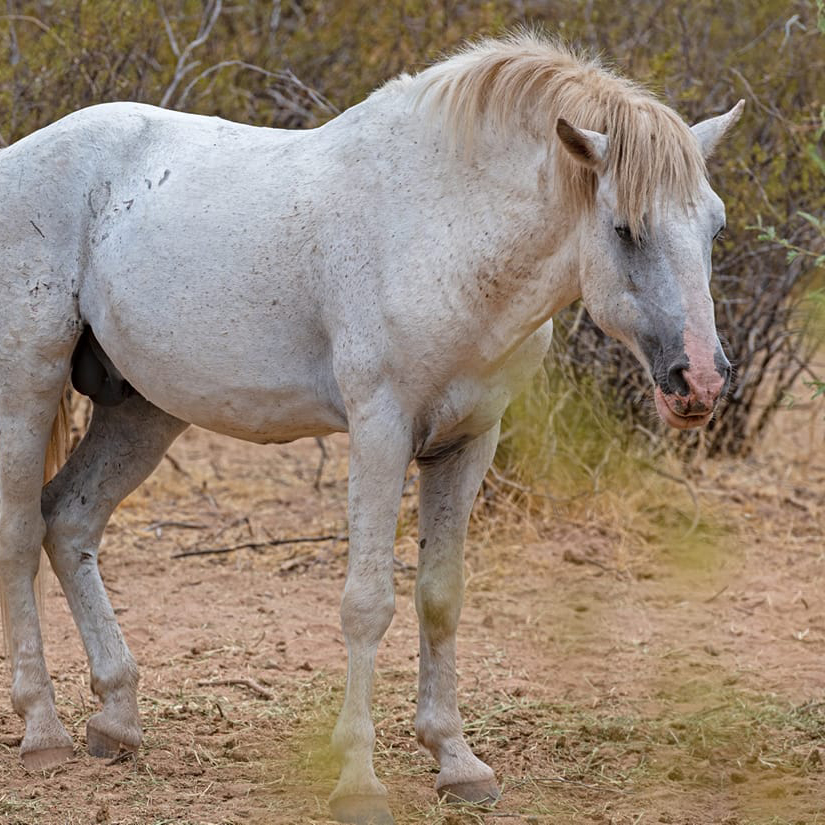
SRWHMG ALERT/DISEASE WARNING.
Possible clinical signs of strangles (Streptococcus Equi) have been discovered and monitored in Salt River wild horses. UPDATE; a test has come back positive for S. Equi bacteria confirming strangles.
Horses affected: 12
Area affected: Sheep’s Crossing and Road 2.2 in the Tonto National Forest.
Horse back riders please be advised that this is contagious to horses. It is not contagious to humans.
While not confirmed yet as definite S. Equi or strangles bacteria, the clinical signs we have observed are lesions under the chin between the two jaw bones, consistent with this equine disease. At this time one dozen Salt River horses have, or had, clinical signs.
The Sheep’s Crossing recreation area is generally closed as well as Rd 2.2. and will remain that way.
Strangles disease or S. Equi, while it has a frightful name, is the most common horse disease in the United States and usually does not kill horses or leave lasting effects on them. It is a disease of the respiratory and lymphatic system. Horses may appear lethargic, lose weight and may display abscesses in lymphoid areas.
Strangles is contagious to other horses, but is not known to transfer to humans or dogs. Antibiotics and vaccinations are only questionably effective and therefore the treatment for strangles in domestic horses is to let it run it’s course.
Because of the serious and contagious nature, SRWHMG is monitoring the afflicted horses closely. Most of the horses who are displaying signs, with the exception of Shadowfax, have appeared to handle it well. They have all stayed and continued to travel with their bands, and some have already healed completely. Shadowfax is also healing and showing great improvement.
SRWHMG is doing some investigating into how this possible infection was introduced to the herd. We keep files and pictures on every horse and in looking back, we have traced the clinical signs to an adult lead stallion named Little Bob, who had a bump next to his eye months ago at the end of July. Our field team had assumed this was just a kick at the time, as that is quite common with lead stallions.
After Little Bob, we had noticed another lead stallion with a lesion. This stallion was photographed running into a forest service sign and we assumed the lesion was related to this incident. However now we see that he had evidence of both wounds from the sign as well as evidence of a lesion below the chin. We believe these were the earliest signs of the infection in the horses. Both of these stallions have now completely healed. Still the infection had to be introduced to them somehow. We do not believe it is related to the relocating of the Butcher Jones horses, as both of these stallions’ bands are not Butcher Jones bands.
We should know more from a swab sample soon, and should it confirm strangles (S Equi) , we will share that information immediately here on our facebook page so please stay tuned. (The lab has informed us that nothing has grown in the sample so far and we should give them a call back on Friday.) SRWHMG is designing signs to put out for warnings for horse back riders in the areas in question.
We are investigating horses in other areas as well and have so far checked on 130 horses who are showing no signs and are healthy.
While we are concerned, we feel there is also no sense in panicking and we are confident that the Salt River wild horses are more than well equipped to deal with this disease quickly and swiftly, since their immune systems are naturally strong. Strangles is not unheard of in wild horse herds, particularly those that are in proximity to domestic horses.
The very best thing that we can do is just leave the horses their space and let them heal. It is not a good idea for people to follow the horses around in order to report on a condition that we, as well as the AZDA, are already aware of. This does nothing to help the horses or speed their recovery.
Horse back riders please be aware that wild horses do travel and that the disease may be present or become present in other areas of the lower Salt River.
This is some myth debunking information on strangles
https://equusmagazine.com/diseases/strangles-myths…
Thank you. SRWHMG
